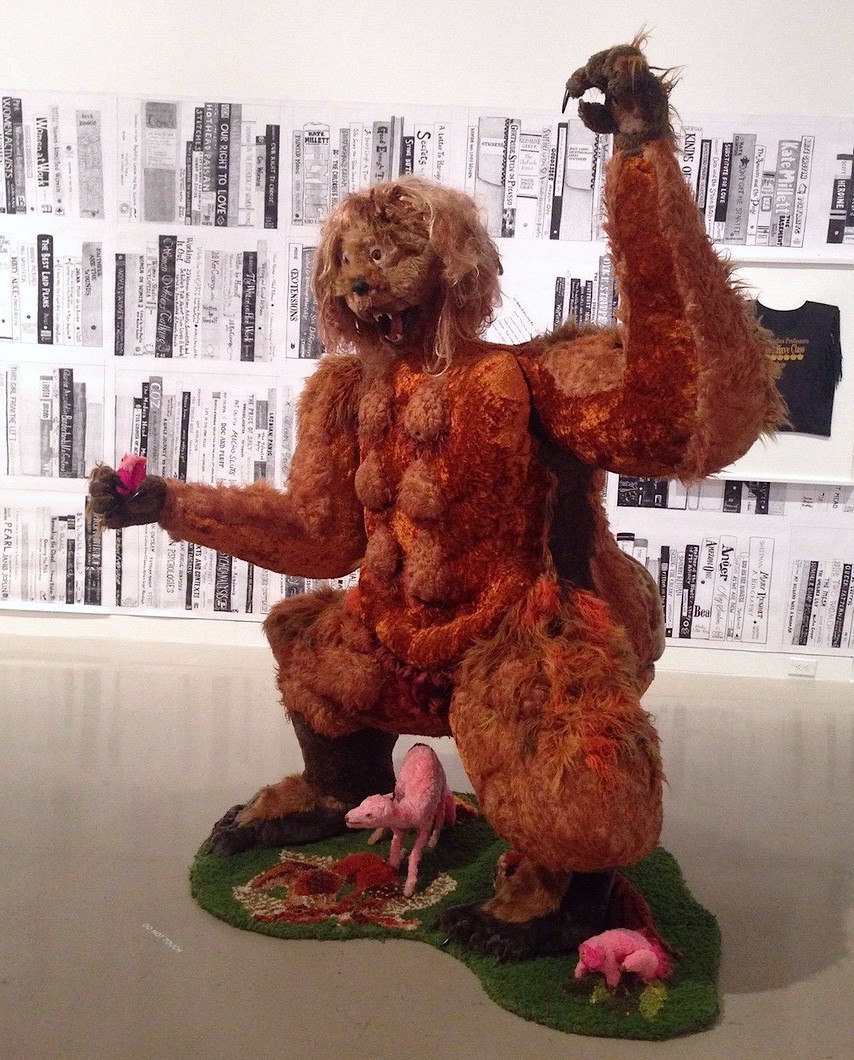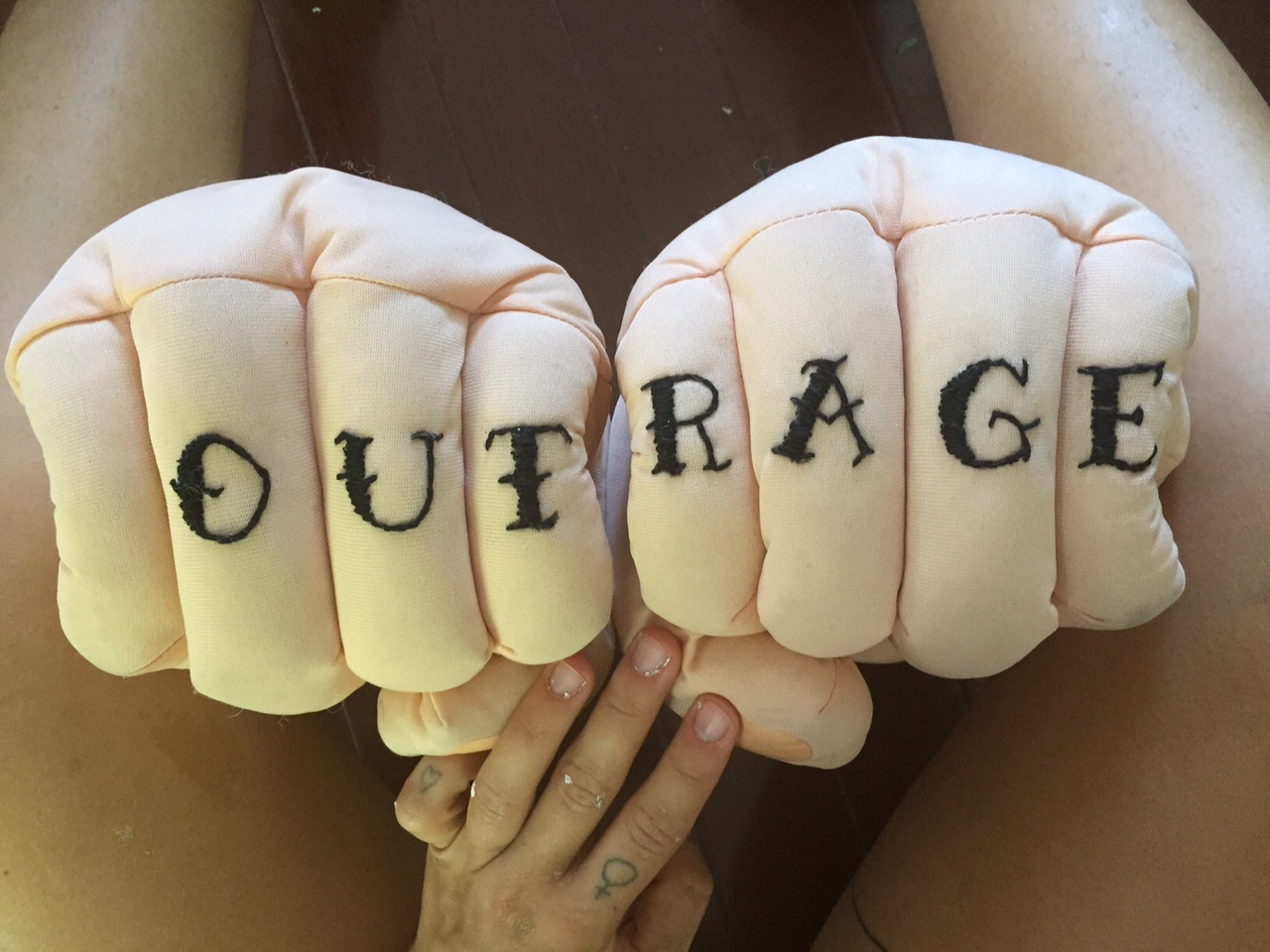
KillJoy’s Kastle, Toronto 2013 (photo by Sarah Westlake)
LOS ANGELES — As Halloween season approaches, haunted houses spring up around the country, turning people’s darkest fears into entertainment. While it’s common to address fears about death and the afterlife, other fears remain outside of the standard seasonal fare, namely those surrounding gender and sexuality. These are precisely the fears confronted head-on by KillJoy’s Kastle: A Lesbian Feminist Haunted House, an installation created by artists Allyson Mitchell and Deirdre Logue.
Mitchell first got the idea when she was traveling around Canada with another artwork of hers, “Ladies Sasquatch” (2006–10). That piece is composed of numerous oversized she-beast figures covered in faux-fur and pelts, complete with cartoonish breasts and, in some cases, plush genitalia. The figures are menacing and whimsically inviting at the same time.

Allyson Mitchell, “Ladies Sasquatch” (detail), as featured in Alien She at the Orange County Museum of Art, 2015 (photo by the author)
Mitchell was surprised when venue after venue asked her to include a warning about sexual or adult content. “What is it that raised an alarm bell for them, that there was something wrong here?” she asked when I sat down with her and Logue last week. “For me, it’s this point that breaks through the polite veneer of contemporary gay acceptance. It’s OK for two white people of the same sex to get married and have a mortgage and pay taxes, but they don’t want dirty, unassimilated dykes. That’s what those sasquatches are — because they’re feral, they’re a coven. After that, it was ‘lesbian feminist’ everything. Let’s push these boundaries and see what happens.”
Mitchell said another influence on the project was the historically common evangelical Christian “Hell Houses,” one of which was featured in the 2001 documentary Hell House. Unlike traditional haunted houses, these are moralizing experiences, highlighting the dangers of “sinful” activities such as drug use, premarital sex, abortion, and homosexuality. At KillJoy’s Kastle, Mitchell and Logue turn this model on its head, replacing a didactic, narrow-minded experience with one that combines playful irreverence with an open-ended exploration of radical feminism.
“We’re using camp aesthetics, sculpture, installation, and performance to undermine those ridiculous stereotypes, but also to investigate some real monstrosities of queer activism and feminist organizing,” Mitchell said. “We’re trying to strike a balance between not only being celebratory, but also trying to dig up some of the more painful ghosts and spirits that are part of our legacies.”

KillJoy’s Kastle, Toronto 2013 (photo by Lisa Kannakko)
When Killjoy’s Kastle premiered in the pair’s native Toronto in 2013, it was wildly popular, with 800 visitors on opening night. It also attracted the attention of the Canadian right-wing media, who were outraged that tax dollars were going to support such a crass example of debauchery. They also seemed completely oblivious to the self-reflexive humor in the piece, unable the look past the tired stereotype of the humorless feminist. (The conservative press finally lost interest when a bigger story broke: the release of a video capturing Rob Ford, then-mayor of Toronto, smoking crack.)
The installation then traveled to the BFI in London for a much smaller show, after which the duo vowed they would never put it on again, as it was such a massive undertaking. But then earlier this year, the ONE National Gay & Lesbian Archives invited them down to stage it in LA. The pair found a perfect location in West Hollywood’s Plummer Park, in a building that served as a meeting place for ACT UP, the activist organization formed in the ’80s to combat the AIDS crisis. For the past few weeks, the artists and a team of volunteers have been working on assembling a spectacle that will fuse craft traditions — tie-dye, papier-mâché, crochet, hand-signage — with lighting and music, all brought to life by a rotating cast of fifty performers.

KillJoy’s Kastle, Toronto 2013 (photo by Lisa Kannakko)
When the house opens this Friday, groups will be escorted through the experience by a “demented women’s studies professor.” On their trip they will encounter such characters as lesbian zombie folk singers, riot ghouls, and polyamorous geriatric vampires. While the artists have kept many aspects from earlier versions alive in this one, they’ve also made some updates. The Crypt of Dead Lesbian Feminist Organizations — a hallowed burial ground for groups whose moment has passed — will be augmented with institutions specific to LA. Partially in response to questions of transphobia, they have also modified the “Ball-Buster” — a character who smashes plaster casts of truck nuts in a critique of white patriarchy. They’re hoping to enlist a prominent local transgender performer to step into that role, putting a new spin on it.
At the end of the tour, visitors meet with real-life feminist killjoys who talk to them about their experience. “Rather than asking people to accept an ideology, we’re asking people to have a critique, to have an opinion, to question it, to question us,” Mitchell said. So we asked a question: What exactly is a feminist killjoy?
“The killjoy comes from Sarah Ahmed, a cultural theorist who wrote this book The Promise of Happiness,” Mitchell told me. “She talks about how feminist killjoys are identified as humorless, as having something wrong with them because they won’t play along. We have a cast of killjoys who are academics, activists, and artists.”
Killjoys are the ones who “ruin Christmas dinner by calling Grandpa out on his racist joke,” Logue adds.
“Or the woman of color in a feminist gathering who asks why she’s the only woman of color there,” says Mitchell.
“They have reputations for holding people accountable and being very vocal and public about that,” says Logue.
“The bottom line is it’s not a trial by fire in the killjoy room,” Mitchell reassures me. “They’re actually really nice and super sweet.”

KillJoy’s Kastle, Intersectional Feminist Room, 2015 (photo by Sarah Westlake)
More than simply poking fun at tired clichés, KillJoy’s Kastle is about critically and playfully reassessing both the history and the future of feminist and queer politics. “There are some ideas from 1970s feminism that are far more radical than the ideas coming out of contemporary lesbian and gay organizing,” Mitchell said. “We don’t have to reinvent the wheel, but let’s try to understand a lesbian feminism that includes trans people, that is anti-racist and sex positive. It’s about trying to create a queer new world.”
KillJoy’s Kastle continues in Plummer Park (1200 North Vista Street, West Hollywood, California) through October 30.
No comments:
Post a Comment